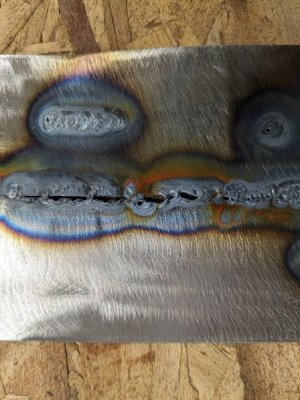Doggggboy
Ultra Member
I'm trying to butt weld some 20 gauge cold rolled sheet metal for the Datsun and not having much luck.
This is my first attempt at tig plus I'm old, half blind and a slow learner so bear with me.
I am using an Everlast 211si welder.
I have cleaned the coupons by grinding and then wiping with brakekleen.
I have ground and cleaned the tungsten.
I have the ground connected directly to the coupon.
The joint is as tight as I can get, almost no gap.
I am not using any filler wire at this point.
With amps at 39, ( 1 amp per thousandth inch as recommended) , I may as well be using a hole punch. It gets better as I reduce amperage but anything lower than 23 gives me no penetration.
I am using a pedal.
I had the argon set at 25cfh but that seemed to almost be blowing the puddle away if I was lucky enough to form one. I've worked my way down to 15 cfh with no improvement.
I have a 1 second upslope and 2 second downslope on the argon.
Occasionally the arc just yeets off the side 1/2 inch or so. I'm assuming that is contamination on the tungsten.
I am using 1/16 ceriated and grinding the tungsten on a fresh flap disk with the grind going axially (while holding my breath)
What I'm doing wrong may be a lengthy list, so am I doing anything correctly?
This is my first attempt at tig plus I'm old, half blind and a slow learner so bear with me.
I am using an Everlast 211si welder.
I have cleaned the coupons by grinding and then wiping with brakekleen.
I have ground and cleaned the tungsten.
I have the ground connected directly to the coupon.
The joint is as tight as I can get, almost no gap.
I am not using any filler wire at this point.
With amps at 39, ( 1 amp per thousandth inch as recommended) , I may as well be using a hole punch. It gets better as I reduce amperage but anything lower than 23 gives me no penetration.
I am using a pedal.
I had the argon set at 25cfh but that seemed to almost be blowing the puddle away if I was lucky enough to form one. I've worked my way down to 15 cfh with no improvement.
I have a 1 second upslope and 2 second downslope on the argon.
Occasionally the arc just yeets off the side 1/2 inch or so. I'm assuming that is contamination on the tungsten.
I am using 1/16 ceriated and grinding the tungsten on a fresh flap disk with the grind going axially (while holding my breath)
What I'm doing wrong may be a lengthy list, so am I doing anything correctly?


